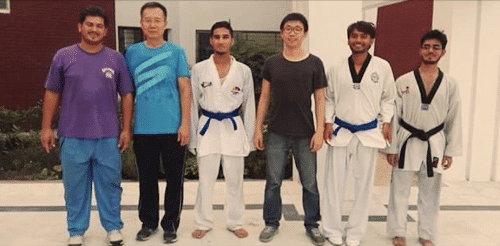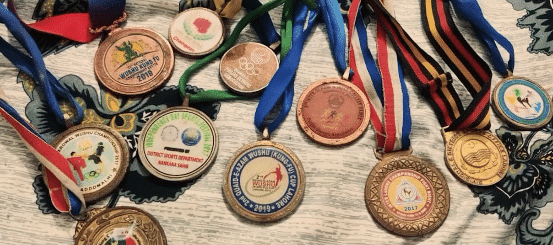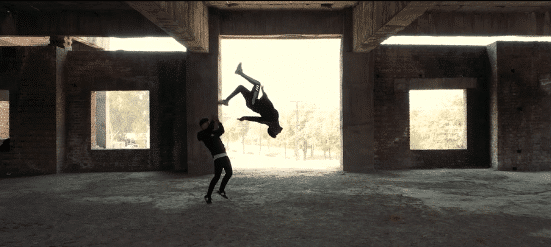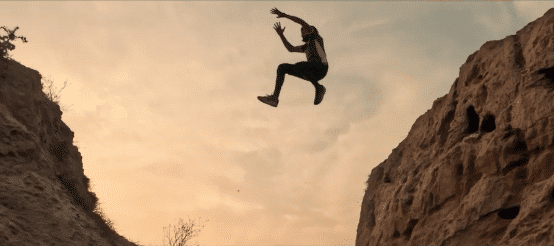Prior to his discovery of parkour, Asim was entrenched in the worlds of taekwondo and kickboxing. While, at this point, fighting is more of a hobby for Asim than a lifestyle, he values all that he has learned from it. In fact, had it not been for his involvement in fighting, he never would have met his best friend Muhammad, and he never would have become a freerunner.
What Are Asim Khan’s Accomplishments as a Fighter?
Influenced by Chinese and Thai martial arts movies, Asim aspired to be a competitive fighter since childhood. In kickboxing and taekwondo, he gave his all and managed to rise to a high level of competition on a national scale.
The highest accomplishment of his fighting career was competing in a district-level taekwondo championship and earning a bronze medal at the 2019 event, which acts as an Olympic qualifier for Pakistan.

Asim’s family was not fully supportive of his fighting career, just as they are equally unenthusiastic about his foray into parkour. Despite his accomplishment taking home a bronze medal, they were less than thrilled at the fact that there was no monetary prize attached.
Even without his family’s support or understanding, Asim has continued to follow his passion for fighting and freerunning, and found that his love of both sports superseeds his need for others’ acceptance.
Asim Khan Makes the Transition from Fighting to Parkour
Fighting was a necessary stepping stone for Asim to get to his current level as an experienced freerunner, as he discovered parkour through competing in martial arts.
At one of his taekwondo competitions, freerunners were hired to perform stunts to warm crowds up for the upcoming fights. Ironically, both Asim and the audience were more enthralled by the parkour tricks than by the main event.

Seeing the artistry of parkour stunts, something instantly clicked within then 16-year-old Asim, and he knew that he wanted to become a freerunner.
He spoke to one of the parkour performers, a teenager named Muhamad, who was more than willing to teach Asim the artform in exchange for training as a fighter. The pair eventually went on to become best friends and fellow freerunners.
What Is Parkour?
According to Parkour UK, “Parkour / Freerunning / Art du Deplacement is the primarily non-competitive physical discipline of training to move freely over and through any terrain using only the abilities of the body, principally through running, jumping, climbing and quadrupedal movement.”
Parkour began in France in the 1990s, when stuntman David Belle sought to create a new athletic artform that would challenge both the bodies and minds of its practitioners. He founded the first parkour crew Yamasaki; until the late 2000s, parkour was a largely underground phenomenon, centered mainly in Europe. However, when parkour clips began going viral on the internet, the sport soon took the world by storm.

Asim’s transition from martial arts to parkour makes a lot of sense when one considers the crossover appeal of the two artforms. Like martial arts, parkour is more than a sport: it is a philosophy. According to Belle, the physical obstacles that free-runners must overcome are metaphors for our obstacles in life. Parkour teaches its practitioners the skills to self-improve.
Parkour runner Andy Tran delves further into the artform’s philosophy, claiming that parkour is “a means of reclaiming what it means to be a human being. It teaches us to move using the natural methods that we should have learned from infancy. It teaches us to touch the world and interact with it, instead of being sheltered by it.”
The Dangers Asim Khan Faces Doing Parkour
In both taekwondo and kickboxing, the worst injury Asim has sustained during his years-long fighting career was a displaced knee that occurred when he blocked an incoming attack. In parkour, injuries that occur while running, jumping, flipping, and twisting are far more common.
However, Asim has noted that freerunning injuries are much easier to hide from his disapproving family members. For fighters, most injuries are visible on the face, with black eyes and broken noses commonplace after a match. Parkour injuries, on the other hand, mostly occur in the legs, so the appearance of being uninjured is often just that: an appearance.

One of the most dangerous stunts Asim ever attempted was a sequence of four moves involving two flips and rolls, and ending with a roundoff. It ended badly, his feet were severely injured and he has never attempted the stunt again.
While that particular stunt was complex, the more simple tricks in Asim’s arsenal are no less dangerous. His most terrifying injury occurred during a simple flip, when he ended up landing on his neck. He was eventually able to get up and walk it off, but he should have gone to a hospital, as the pain and numbness from the injury lasted for weeks after the failed stunt.
With a baby on the way and a wife who is terrified to lose him, Asim is being more careful in his approach to parkour, but still practices daily and has no intentions of giving up the sport he loves at 23-years-old.